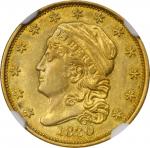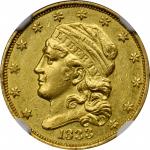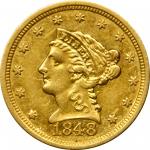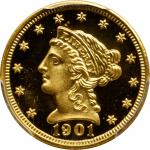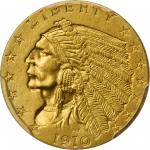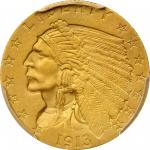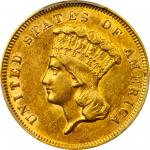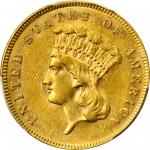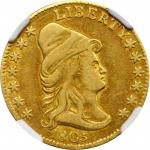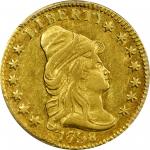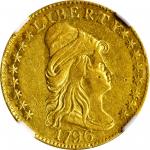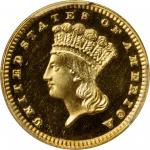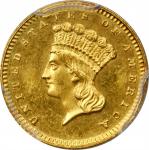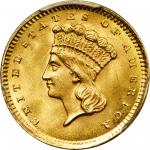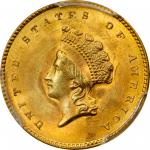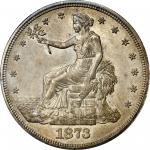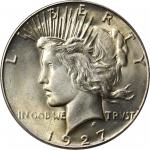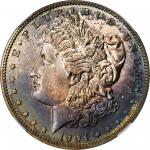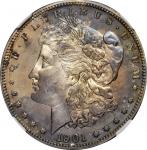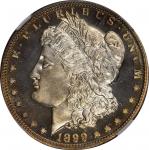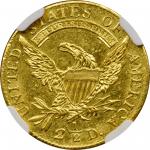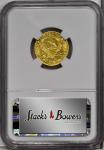1808 Capped Bust Left Quarter Eagle. BD-1, the only known dies. Rarity-4. MS-62 (NGC).
This is a splendid Mint State example of a classic one year design type in the early U.S. Mint gold series. In fact, for the completion of a basic type set of federal coins from the half cent to the double eagle, the 1808 quarter is the key challenge. In Mint State the 1808 is even more so, as years can pass between auction appearances.<p> Bright satin to semi-reflective luster shines forth from pretty golden-yellow surfaces. The strike is sharp on Libertys curls and the eagle, but most of the stars lack their radial centers and there is scant denticulation around the borders, as nearly always noted on extant 1808 quarter eagles. BD Die State b.<p>In everyday commercial activities, the quarter eagle was never especially popular. The half eagle was a more convenient way of handling overseas transactions since it better approximated (though not perfectly) some of the frequently encountered gold coins in Europe. Domestically, bullion depositors seldom requested the quarter eagle, opting instead for the half eagle. Consequently, production of the denomination came in fits and starts throughout the early decades of its existence and rarely in large numbers. Such is the case with the 1808 Draped Bust quarter eagle, now considered an essential component in any advanced type set and a classic American rarity.
The 1808 quarter eagle got its start as part of an effort by Mint Director Robert Maskell Patterson to modernize the designs of the nations coinage. Originally from Bavaria, Johann Matthaus Reich, came from a long line of clockmakers and engravers. Taking up the family occupation, he began engraving on his own achieving some measure of success. He arrived in Philadelphia in 1800 and quickly secured employment at the new Mint. Even though Reich expected to work on engraving dies for coins, Chief Engraver Robert Scot had different ideas and assigned rather minor tasks to Reich. Disenchanted with his small role, Reich enlisted the help of Mint Director Robert Patterson, who secured for Reich a long-overdue promotion to the position of assistant engraver. As part of his promotion, Reich was tasked by Patterson to perform a wholesale redesign of all the currently circulating coinage starting with the half dollar and half eagle. The new designs met with approval and remained current well into the 1830s. Buoyed by this early success, Reich next turned his attention to the cent and quarter eagle. Borrowing heavily from his half dollar and half eagle, Reichs quarter eagle design featured a bust of Liberty facing left and wearing a large cap inscribed LIBERTY as well as a dress that is pinned at her shoulder with an oval ornament.
The stars on the obverse were arranged 7 on the left and 6 on the right; the final star on the right side marked with a small notch serving as a hidden "signature" of sorts, a feature he continued to use until 1817 when Reich finally left the Mints service after a request for a raise was denied. Scots Heraldic Eagle design was completely scrapped in favor of a more naturalistic eagle standing with its wings stretched up and facing left with the eagles breast protected by a large shield. Reich also made a significant heraldic change that some from the era might have called an overdue correction: he moved the olive branch to the left claw (considered the position of honor) and the arrows to its right claw. Taking a cue from his earlier designs, Reich placed the denomination value below the eagle in the hope that adding the denomination would encourage greater international acceptance of Americas coins.
Because of desultory interest from banks and merchants for the denomination, only one pair of dies was required to produce the entire mintage of 2,710 quarter eagles in 1808. Right from the outset, the obverse die suffered a crack that runs from the top of Libertys cap to the stars on the right which appears on all known specimens. In addition, an unintentional slip of an engraving tool while preparing the sole reverse die caused a small thin vertical die scratch on the left wing edge below the eagles beak. Both these marks serve as important diagnostic tools for the numismatist. Since there were so few requests for the denomination by the Mints bullion depositors, production of the quarter eagle was suspended until 1821, at which time it featured a new design as Reich had long since left the Mint.
While many 1808 quarter eagles met their fate in the bullion speculators crucible during the widespread melts of the 1820s and 1830s, enough remained that early numismatists recognized the importance of the coin. It has long been recognized as a great type coin, even if the actual rarity has sometimes been miscalculated. For many years, some numismatists claimed as few as 35 to 40 remained extant, but with the advent of the certification services and tracking in recent decades, the numbers have since been revised to approximately 125 to 200 extant specimens. By any measure the 1808 quarter eagle is a challenging coin to acquire in any grade. Fortunately, most are found in the higher circulated grade levels, attesting to their rather limited time in commerce. A tiny number of Uncirculated pieces -- between 8 and 12 by most estimates -- are known and are ardently pursued. Only one Gem Mint State coin is known, the simply fabulous Pogue specimen we had the pleasure of offering at auction in 2015. Likely Condition Census, the present coin counts among the finest known of this important one-year type.

